Speaking of endangered ocean species, the earth is now in the midst of its sixth mass extinction of plants and animals — the sixth wave of extinctions in the past half-billion years. The situation is almost as bad as that 65 million years ago when the dinosaurs became extinct. Despite the fact that extinction is a natural phenomenon, it has a background rate of one to five species a year.
However, scientists have reported that we are losing species at an alarming rate of 1,000 to 10,000 times the background rate. At this rate, we are seeing the loss of almost a dozen species every day and it will not be long before 50% of all the species will become extinct. That is a scary future indeed.
There is no one to blame for this calamity than us humans. We have been mistreating the environment to suit our needs, totally oblivious to the repercussions. As the need for water is increasing for various industrial or agricultural purposes, we are building dams without a second thought.
We dump our toxic wastes from factories and households into the water bodies. This has made the aquatic ecosystem the most affected areas and it is no surprise that so many fish and other aquatic animals have become endangered.
All the ecosystems are interconnected and interdependent in one way or the other so when there is an imbalance in one, it impacts the other ecosystems as well. As a result, human interventions are causing ecological imbalances in epic proportions.
Animals belonging to the terrestrial ecosystem like the Black rhino, the orangutan, Arum leopard, and the giant pandas, are under great danger. Likewise, turtles, salmonids and marine mammals like the blue whale, belonging to the marine ecosystem are also in danger.
The International Union for Conservation of Nature or the IUCN has declared hundreds of species across the world to be in the list of critically endangered species. This is mostly due to overfishing and climate change which in itself is a consequence of human negligence. This article covers some of those marine lives who are critically endangered.
The following are some of the aquatic animals or species that are on the verge of extinction.
Here is the list of 18 Endangered Ocean Species and Marine Animals
1) Green sea turtle (Cheloniamydas)
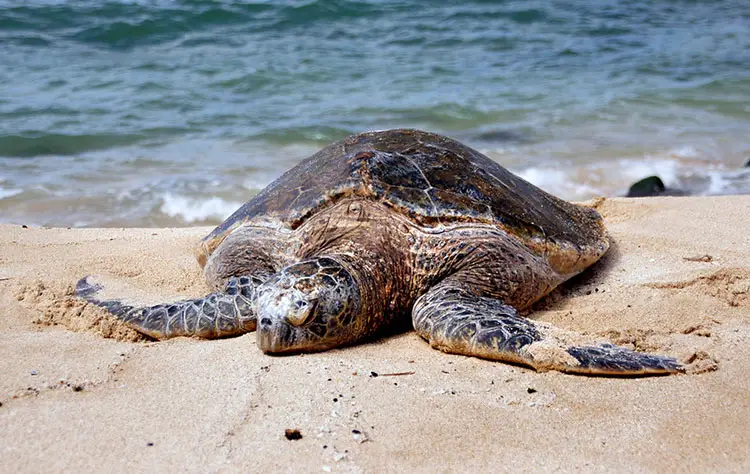
The Green Sea turtle is an herbivore and falls in the list of the largest turtles. They are found in tropical and subtropical seas. The name comes from the color of the fat found under its shell. Their lengths can vary from 3 ft to 4 ft. The largest green sea turtle found had a length of 5 ft and weighed 395 kg. Similar to many other varieties of turtles, they leave their hatching beaches in search of food.
Unfortunately, they themselves are popular food items and even their eggs are sold as delicacies in certain parts of the world, leading to a gradual decline in their population. Careless fishing is also an indirect cause of their endangerment. No wonder, they are one of the most endangered ocean species.
2) Hawksbill Turtle (Eretmochelys imbricate)
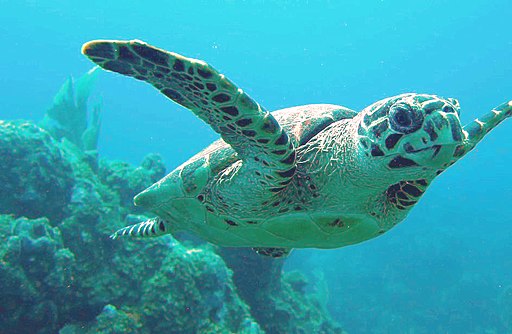
Hawksbill Turtle is an object of heavy trafficking leading to an alarming 80% decline in their population just in the last century. Mostly found in tropical oceans and coral reefs they inhabit the oceans, gulfs, and seas of the world.
Their shells are beautifully patterned and colorful, thus making them extremely valuable in the black market. Hence, they are brutally killed for their shells. Many countries have banned the harvesting of their eggs, but it has turned out to be an effort in vain.
The degradation of coral reefs is also one of the prime reasons for the decline of their species. It is because this is their primary food. Also, they are vital for the existence of seagrass and coral beds because of interdependence. Marine conservatives believe that these turtles belong to a family of reptiles that existed on our planet for a hundred million years.
3) Kemp’s Ridley sea turtle (Lepidochelys kempii)
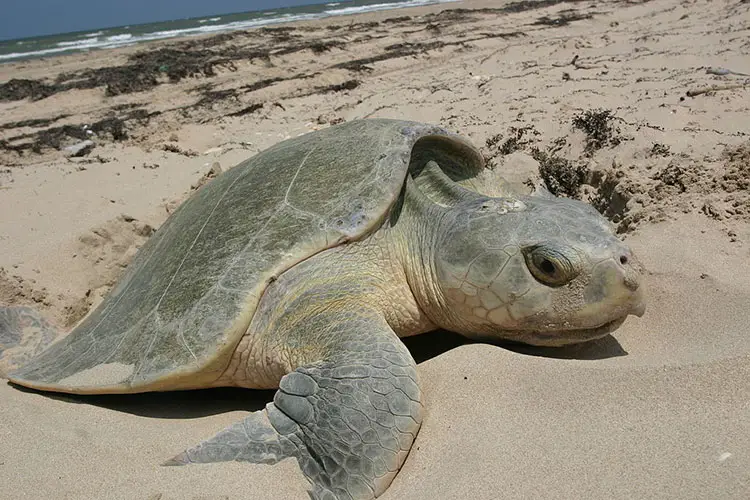
Kemp’s Ridley sea turtles are mostly found in the Gulf of Mexico. They often migrate to the Atlantic Ocean but come back to lay eggs. They are also known as the Atlantic Ridley. They are small and the number of them still alive is smaller. They have unique nesting habits. The females come to the beaches in large numbers to lay eggs. This process is called Arribadas.
They can weigh up to a hundred pounds and can live for as many as 50 years.
They have become extremely rare, mostly due to the damage to and consequently loss of their habitat, marine pollution, getting caught in fishing nets, etc. The harvesting of their eggs has been made illegal and research teams have taken up the project of conserving them through incubation and controlled environment suitable for hatching eggs.
4. Blue Whale (Balaenoptera musculus)
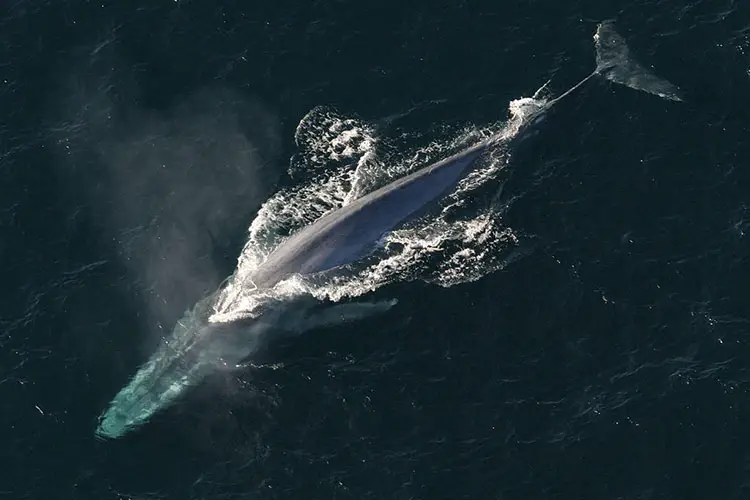
Weighing at around 200 tonnes, the 100 feet long blue whale happens to be the largest living mammal on the planet. It belongs to the baleen whales and has at least three subspecies. Blue whales migrate from both poles in the oceans around the world and are at the top of the food chain. This gives the blue whale the most important task of maintaining a healthy marine environment.
Humans have created much disruption in this noble work of the whales as they are hunted for commercial purposes, despite the international ban in 1966, resulting in a sharp decline in their population so much so that their existence is threatened. Based on IUCN’s 2016 report, the estimated global population of the Blue Whale is 10,000 -25,000.
5. Fin whale (Balaenopteraphysalus)
The Fin whale is the second-largest mammal on the planet after the Blue Whale weighing at around 114 tonnes and having a length of 25.9 m. It is also known as common rorqual and like other whales has fallen prey to human greed. They are hunted for their fur and meat. As a result, their global population has gone down by quite a lot and now there are only 100,000 to 119,000 Fin Whales in the whole world.
Humpback Whale is another member of the rorqual species and just like the Fin Whale has been listed under the endangered marine species. Their population had gone down by 90% by the time a ban on whaling had been made official. Only 2,500 of them are still alive.
6. Vaquita (Phoeocna sinus)
The saddest thing about Vaquita is the fact that they are on the verge of extinction just within half a century of its first sighting. They are the smallest cetacean and are critically endangered. They live in the shallow murky waters of the Baja Peninsula in Mexico. A Vaquita can be recognized from the dark rings around its eyes, dark patches on its lips and a thin line extending from the mouth to dorsal fins.
The Gulf of California has witnessed a major use of gill-netting for fishing. Despite the fact that gill-netting operations are no longer carried out and have been so since the 1970s, their population keeps decreasing every year at an alarming rate of 15% per year. Reports say that there are only around 12 of these mammals left in the world ever since their population declined by a shocking 90% by 2011.
7. Hector’s Dolphin (Cephalorhynchus hectori)
Hector’s Dolphins happen to be the smallest and rarest dolphins in the world are also the most prominent dolphin in the genus Cephalorhynchus. They are found off the coast of New Zealand and are mostly sighted around the South Island. They have a broad body and black markings on their faces. Their throat and belly are creamy white in color. They move in groups of two to eight.
Trawl fisheries and bottom-set gill nets happen to be the main cause of their deaths and have led to a major decline in their population. The fishing nets are mostly responsible for their deaths. One of their most endangered of the sub-species happens to be Maui’s dolphin. Their population over the world is estimated to be just about 7000.
8. Hammerhead Shark (Sphyrnidae)
The Hammerhead shark belongs to the family Sphyrnidae and was given the name because of its “hammer” shaped head. The Hammerhead weighs up to 580 kg and their measure in length ranges from 0.9 to 6 meters. They are found in the tropical regions of the oceans around the world. They eat smaller fish, squid crustaceans and octopuses. They are dangerous hunters and are known to attack humans, even if they are unprovoked.
These majestic sharks are hunted for their fins and are brutally tortured as their fins are cut off from their bodies while they are alive. The remaining are thrown back into the water where they die from bleeding. The ban put on shark finning in many countries has not been of much use due to its high demand in the Asian markets which thrives on its illegal harvesting. This has drastically lowered its population and is continuing to do so.
9. Hawaiian Monk Seal (Neomonachus schauinslandi)
Hawaiian Monk Seal is one of the earless seals who live in the warm beaches of the North-western Hawaiian Islands. This characteristic separates it from other seals. The Caribbean monk seal has already become extinct. It belonged to the same family of monk seals. The only other member of the family remaining in the Mediterranean monk seal. Recent research suggests there are only around 1,400 Hawaiian Monk Seal remaining on the Islands now.
This is largely due to commercial hunting for meat, oil, and skin as well as the threat posed by predators including tiger sharks. They often get entangled in fishing nets and are heavily affected by marine debris.
10. Steller Sea Lion (Eumetopias jubatus)
Inhabiting the cold coastal waters of the North Pacific, the Stellar Sea Lion is the largest member of the Otariid family and the fourth largest of all seal species. It is also known as the northern sea lion. It was discovered and named after Georg Wilhelm Steller, a naturalist who first saw them in 1741.
Native Alaskans and Canadians hunt them for meat, oil, hides and other by-products. This coupled with the high risk of predation by Killer Whales has caused them to be on the brink of extinction. Reports suggest that their population has declined by more than 60% due to both natural and human threats since the 1960s. However, the good news is that their increasing population in recent years has resulted in their omission from the U.S. Endangered Species List in 2013.
Read more: What Is A Marine Biologist?
11. Ganges River Dolphin (Platanista gangetica)
The Ganges River dolphin is found in the Ganges-Brahmaputra-Meghna and Karnaphuli-Sangu river systems of Nepal, India, and Bangladesh. They have a long thin snout, rounded belly, stocky body, and large flippers. Their eyes lack lens and they hence are also referred to as the “blind dolphin”. Still, they use their eyes to locate themselves. The species has a slit on the top of the head, similar to a blowhole, which acts as a nostril. They are greyish brown in color. The younger ones are dark in color and as they grow old their color lightens.
They live in one of the most densely populated areas of the world and are slowly becoming extinct due to the number of dams that are being built every now and then. Apart from that, deforestation, pollution, and entanglement in fisheries and nets have steadily contributed towards the decline of their population. Also because of the barrages, the course of the river is also getting affected which in turn is affecting the species. It is estimated that only 1,200 – 1,800 of these species remain.
12. Spear Tooth Shark (Glyphis glyphis)
Spear tooth sharks are found in Queensland and in the Northern Territory of Australia. They are an extremely rare member of the river shark genus, belonging to the family of Carcharhinidae. They are mainly found in fast-moving, highly turbid waters that vary widely in salinity. They are grey-colored and robustly built having a short broad snout, tiny eyes, and a large second dorsal fin. They also have a black blotch near the tip of their pectoral fin.
Of course, their most outstanding feature is their large, triangular, serrated teeth in their upper jaw and narrow spear-like teeth serrated only near the end in their lower jaw. They measure to about 2.6 meters in length.
Their population has drastically declined due to pollution from mining operations, commercial fishing and recreational fishing in its brackish coastal habitats. Only 250-2,500 of them remain today.
13. Giant Devil Ray (Mobula mobular)
Giant Devil Ray (Mobula mobular) is the largest species of the genus Mobula. They are mostly found in the Mediterranean Sea and possibly the adjoining North Atlantic waters. They are taken as bycatch in many different fisheries. Due to low reproductive capacity, restricted range and high mortality as bycatch they had been categorized as Endangered in 2006. Their population is estimated to reduce by 50% over three generations pertaining to their high mortality range.
There are several other endangered marine species like the Hooded Seal, Great White Sharks, Dugongs, etc. Though many activists are trying to make a difference, most of their work is, unfortunately, going in vain. Maybe they should focus on conserving the species that are not endangered yet as that would be a far more achievable task, but sadly that is not what is being done.
14. Bluefin Tuna (Thunnus thynnus)
The bluefin tuna, also known as the aquatic bluefin tuna, the northern bluefin tuna or the giant bluefin tuna is a species of tuna fish. It belongs to the family of Scombridae. These fish are native to the Atlantic Ocean and the Mediterranean Sea. This species has already become extinct in the black sea and is on the verge of extinction in other parts of the world as well.
They can have a mass of more than 150 kg and yet this fish has an extraordinary ability to dive over 4000 ft. It is also a very popular dish all over the world and this is one of the reasons for its current situation. Other reasons for this are overfishing and not knowing about its lifecycle. Only about 40,000 bluefin tuna fishes are remaining today.
15. Galápago Penguin (Spheniscus mendiculus)
The Galápago Penguin is a species of penguin. It is the only species of penguin found in the north of the equator. They are named after the Galapagos Islands. They are small animals with a weight of not more than 2.5 kg and a height of 49 cm. It is one of the most critically endangered marine species on the planet with a remaining population of just about 2000. The main reasons behind this are climate change and overfishing. Recently, the introduction of domestic islands in the Galapagos Islands has been one of the prime reasons. Other threats to them include bycatch and pollution.
16. Florida Manatee (Trichechus manatus)
The Florida Manatee is a marine species that are found off the coast of Florida, USA. It is the aquatic relative of the elephant. They are generally 10 to 12 feet in length and can weigh as much as 800 kg. They are herbivores. Today, only 3000 to 6000 Florida Manatees remain. The major threats to their existence are pollution, climate change, habitat loss boat strikes, and commercial development. There are several organizations that aim at conserving this species. One can contribute by making donations or symbolically adopting them.
17. Sea Otter (Enhydra lutris)
The Sea Otter is an aquatic animal that belongs to the Weasel family. It is normally found along the coasts of the Pacific Ocean and in parts of Asia. They can grow up to a height of 4 ft and live for about 15 to 20 years on average. The main threats to sea otters are oil spills, habitat degradation, shark attacks, and hunting. Their population is about 106,000 all over the world. They are endangered species protected by law.
from WordPress https://www.maritimemanual.com/endangered-ocean-species-and-water-animals/
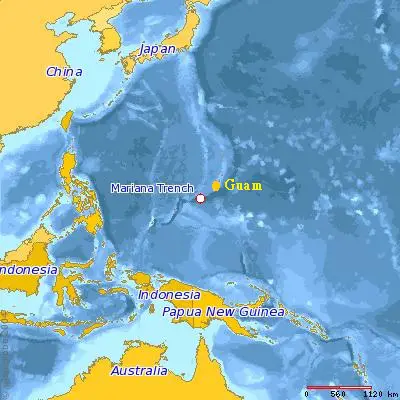
No comments:
Post a Comment